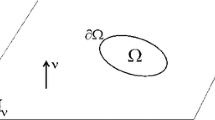Abstract
In this part II, the influence of thermal vibration on the shape of a crack front and on the conditions for crack motion are investigated. We have considered a static crack model in mode I loading in a linear isotropic elastic medium whose front vibrates in the form of a standing wave with displacement ξ perpendicular to both the average crack plane and the crack propagation direction; ξis assumed to be sum of standing sine waves and the crack to be represented by a continuous distribution of vibrating edge dislocations. The displacement and stress fields due to an infinitely long edge dislocation, oscillating in the form of a standing wave, are first given. Then it is shown that, in free vibration conditions, ξ would satisfy the d'Alembert wave equation with a constant phase velocity corresponding to the velocity of a travelling sine wave along an edge dislocation. It is also shown that the sites for the initiation of crack motion are located on the average crack plane at the nodes of the vibrating crack front. The crack opening force G per unit length of the crack front, at the sites of crack propagation initiation, is found to be different from that of the rigid planar crack, when averaged over time, but the magnitude of the difference is relatively small. G decreases with increasing temperature T and is found to be proportional to T 2 at very low temperature and to T at higher temperatures. The relation for G leads to view the vibrating crack front as being non straight on average over time. In tungsten, a nearly isotropic material, the theory yields a mean crack front inclination angle of about 1° at absolute zero, 3.2° at room temperature and 10.6° at the melting point.
Similar content being viewed by others
References
Anongba, P.N.B. (1995). The displacement and stress fields due to a sinusoidal edge dislocation. Physica Status Solidi B190, 135-149.
Anongba, P.N.B. (1996). A non-planar crack analysis using continuously distributed sinusoidal edge dislocations and linear elasticity. Physica Status Solidi B194, 443-452.
Anongba, P.N.B. and Vitek, V. (2003). Significance of the deviations of the crack front into the plane perpendicular to the crack propagation direction, Part I. Crack-front dislocation generation. International Journal of Fracture, submitted.
Bilby, B.A. and Eshelby, J.D. (1968). Dislocations and the theory of fracture. In: Fracture (Edited by H. Liebowitz), Vol. 1, Academic Press, New York, 99-182.
Desjonquères, M.-C. and Spanjaard, D. (1993). Concepts in Surface Physics, Springer-Verlag, Berlin.
Eshelby, J.D. (1962). The interaction of kinks and elastic waves. Proceedings, Royal Society London A266, 222-246.
George, A. and Michot, G. (1993). Dislocation loops at crack tips: nucleation and growth-an experimental study in silicon. Materials Science and Engineering A164, 118-134.
Kittel, C. (1972). Introduction à la physique de l'état solide, troisième édition, Bordas, Paris.
Kittel, C. (1996). Introduction to Solid State Physics, 7th edition, John Wiley, New York.
Laub, T. and Eshelby, J.D. (1966). The velocity of a wave along a dislocation. Philosophical Magazine 14, 1285-1293.
Mura, T. (1987). Micromechanics of Defects in Solids, Martinus Nijhoff Publishers, Dordrecht.
Peach, M.O. and Koehler, J.S. (1950). The force exerted on dislocations and the stress field produced by them. Physical Review 80, 436-439.
Author information
Authors and Affiliations
Rights and permissions
About this article
Cite this article
Anongba, P. Significance of the deviations of the crack front into the plane perpendicular to the crack propagation direction - II. Crack-front vibration. International Journal of Fracture 124, 17–31 (2003). https://doi.org/10.1023/B:FRAC.0000009224.79739.8b
Issue Date:
DOI: https://doi.org/10.1023/B:FRAC.0000009224.79739.8b




